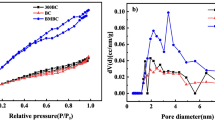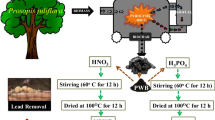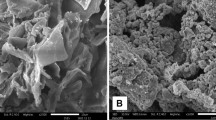Abstract
The ammonia nitrogen (AN) pollution caused by the mining of weathered crust elution-deposited rare earth ore (WCED-REO) poses a huge threat to the environment. Therefore, developing an economical and efficient treatment for AN pollution is extremely necessary. Jiangxi province has abundant bamboo resources. In this work, the cheap and easily available bamboo charcoal (BC) was used as the raw material of the adsorbent, and potassium permanganate (KMnO4) and sodium silicate (Na2SiO3) co-modified bamboo charcoal (KSBC) was fabricated. The results showed that KSBC contained rich microporous structure with abundant functional groups. When the initial pH of the solution was 7.0, the initial AN concentration was 100 mg/L, and the solid-to-liquid ratio was 10 g/L, the maximum adsorption capacity of NH4+-N by KSBC was 7.2 mg/g, which was 4 times larger than that of BC. We also carried out interference experiments with representative ions in WCED-REO areas, and KSBC showed a good performance in the presence of some interferents. Density functional theory (DFT) calculation was also used to further elucidate the reason of reducing participation from interferents. The adsorption mechanism mainly includes electrostatic interaction, surface complexation, and ion exchange interaction. The results of desorption experiments showed that the contribution of electrostatic interaction and ion exchange to the removal of AN was 86.29% of the adsorption efficiency, implying a good regeneration potential. These results could provide theoretical support and guidance for development and application of BC-based biochar adsorption material in the treatment of nitrogen-contaminated water in WCED-REO areas.
Graphical Abstract







Similar content being viewed by others
Data Availability
The data that support the findings of this study are available on request from the corresponding author Q. Xue. The data are not publicly available due to them containing information that could compromise research participant privacy.
References
Ali, I., Asim, M., & Khan, T. A. (2012). Low cost adsorbents for the removal of organic pollutants from wastewater. Journal of Environmental Management, 113, 170–183.
Angar, Y., Djelali, N. E., & Kebbouche-Gana, S. (2017). Investigation of ammonium adsorption on Algerian natural bentonite. Environmental Science and Pollution Research, 24, 11078–11089.
Arami, M., Limaee, N. Y., & Mahmoodi, N. M. (2008). Evaluation of the adsorption kinetics and equilibrium for the potential removal of acid dyes using a biosorbent. Chemical Engineering Journal, 139, 2–10.
Astals, S., Martinez-Martorell, M., Huete-Hernandez, S., Aguilar-Pozo, V. B., Dosta, J., & Chimenos, J. M. (2021). Nitrogen recovery from pig slurry by struvite precipitation using a low-cost magnesium oxide. Science of the Total Environment, 768, 8.
Bhardwaj, A., Nag, S., Dahiya, A., Pandey, P., Arora, M., & Babu, J. N. (2022). Effect of Pyrolysis Temperature on Mechanistic Transformation for Adsorption of Methylene Blue on Leached Rice-Straw Biochar. CLEAN-Soil, Air, Water, 50, 2100108.
Bhardwaj, A., Nag, S., Hussain, K., Pandey, P., Babu, J., N. (2022b): Effect of temperature and fly ash content on the catalytically pyrolyzed rice straw biochar-fly ash composites for methylene blue adsorption. Asia-Pacific Journal of Chemical Engineering
Boehm, H. P. (1994). Some aspects of the surface-chemistry of carbon-blacks and other carbons. Carbon, 32, 759–769.
Boopathy, R., Karthikeyan, S., Mandal, A. B., & Sekaran, G. (2013). Adsorption of ammonium ion by coconut shell-activated carbon from aqueous solution: Kinetic, isotherm, and thermodynamic studies. Environmental Science and Pollution Research, 20, 533–542.
Chang, H. X., Hu, R., Zou, Y. J., Quan, X. J., Zhong, N. B., Zhao, S., & Sun, Y. H. (2020). Highly efficient reverse osmosis concentrate remediation by microalgae for biolipid production assisted with electrooxidation. Water Research, 174, 11.
Chang, H. X., Zou, Y. J., Hu, R., Feng, H. W., Wu, H. H., Zhong, N. B., & Hu, J. J. (2020). Membrane applications for microbial energy conversion: A review. Environmental Chemistry Letters, 18, 1581–1592.
Chen, W. H., Liu, S. H., Juang, T. T., Tsai, C. M., & Zhuang, Y. Q. (2015). Characterization of solid and liquid products from bamboo torrefaction. Applied Energy, 160, 829–835.
Cheng, H. M., Zhu, Q., & Xing, Z. P. (2019). Adsorption of ammonia nitrogen in low temperature domestic wastewater by modification bentonite. Journal of Cleaner Production, 233, 720–730.
Cornelissen, G., Kukulska, Z., Kalaitzidis, S., Christanis, K., & Gustafsson, O. (2004). Relations between environmental black carbon sorption and geochemical sorbent characteristics. Environmental Science and Technology, 38, 3632–3640.
Cui, X. Q., Hao, H. L., Zhang, C. K., He, Z. L., & Yang, X. E. (2016). Capacity and mechanisms of ammonium and cadmium sorption on different wetland-plant derived biochars. Science of the Total Environment, 539, 566–575.
Fan, X., Xue, Q., Liu, S. W., Tang, J., Qiao, J. Y., Huang, Y. Y., Sun, J. M., & Liu, N. N. (2021). The influence of soil particle size distribution and clay minerals on ammonium nitrogen in weathered crust elution-deposited rare earth tailing. Ecotox and Environmental Safety, 208, 9.
Genethliou, C., Triantaphyllidou, I. E., Giannakis, D., Papayianni, M., Sygellou, L., Tekerlekopoulou, A. G., Koutsoukos, P., & Vayenas, D. V. (2021). Simultaneous removal of ammonium nitrogen, dissolved chemical oxygen demand and color from sanitary landfill leachate using natural zeolite. Journal of Hazardous Materials, 406, 19.
Gong, Y. P., Ni, Z. Y., Xiong, Z. Z., Cheng, L. H., & Xu, X. H. (2017). Phosphate and ammonium adsorption of the modified biochar based on Phragmites australis after phytoremediation. Environmental Science and Pollution Research, 24, 8326–8335.
Han, B., Butterly, C., Zhang, W., He, J. Z., & Chen, D. L. (2021). Adsorbent materials for ammonium and ammonia removal: A review. Journal of Cleaner Production, 283, 19.
Hasanoglu, A., Romero, J., Perez, B., & Plaza, A. (2010). Ammonia removal from wastewater streams through membrane contactors: Experimental and theoretical analysis of operation parameters and configuration. Chemical Engineering Journal, 160, 530–537.
Hou, J., Huang, L., Yang, Z. M., Zhao, Y. Q., Deng, C. R., Chen, Y. C., & Li, X. (2016). Adsorption of ammonium on biochar prepared from giant reed. Environmental Science and Pollution Research, 23, 19107–19115.
Huang, H. M., Xiao, X. M., & Yan, B. (2009). Complex treatment of the ammonium nitrogen wastewater from rare-earth separation plant. Desalination and Water Treatment, 8, 109–117.
Huang, X. W., Long, Z. Q., Wang, L. S., & Feng, Z. Y. (2015). Technology development for rare earth cleaner hydrometallurgy in China. Rare Metals, 34, 215–222.
Huang, H., Yao, W., Li, R., Ali, A., Du, J., Guo, D., Xiao, R., Guo, Z., Zhang, Z., & Awasthi, M. K. (2018). Effect of pyrolysis temperature on chemical form, behavior and environmental risk of Zn, Pb and Cd in biochar produced from phytoremediation residue. Bioresource Technology, 249, 487–493.
Huang, X., Bai, J., Li, K. R., Zhao, Y. G., Tian, W. J., & Hu, C. H. (2020). Preparation of clay/biochar composite adsorption particle and performance for ammonia nitrogen removal from aqueous solution. Journal of Ocean University, 19, 729–739.
Ilay, R. (2020). Short-lived effects of olive pomace biochar produced at different temperatures on nitrate (NO3-), bromide (Br-), sulfate (SO42-) and phosphate (PO43-) leaching from sandy loam soils. Communications in Soil Science and Plant Analysis, 51, 2223–2243.
James King’ori, N., Zhang, R., Li, Y., Wang, X., Wang, J., & Zhao, J. (2018). Synthesis and characterization of magnesium modified biochar for ammonia and phosphorus immobilization from simulated wastewater. Acta Scientiae Circumstantiae, 38, 4383–4390.
Jing, Q. X., Chai, L. Y., Huang, X. D., Tang, C. J., Guo, H., & Wang, W. (2017). Behavior of ammonium adsorption by clay mineral halloysite. Transactions of the Nonferrous Metals Society of China, 27, 1627–1635.
Li, C. Y., Li, W. G., & Wei, L. (2012). Research on absorption of ammonia by Nitric acid-modified Bamboo Charcoal at low temperature. Desalination and Water Treatment, 47, 3–10.
Li, Z. N., Zhu, Z. Q., Liang, M. N., Qin, H. D., & Zhu, Y. N. (2012). Research on influence factors of bamboo charcoal adsorb ammonia nitrogen in wastewater. In D. Zhang (Ed.), Li H, Xu QJ (pp. 493–497). Progress in environmental science and engineering. advanced materials research. Trans Tech Publications Ltd.
Li, R., Wang, J. J., Gaston, L. A., Zhou, B., Li, M., Xiao, R., Wang, Q., Zhang, Z., Huang, H., Liang, W., Huang, H., & Zhang, X. (2018). An overview of carbothermal synthesis of metal–biochar composites for the removal of oxyanion contaminants from aqueous solution. Carbon, 129, 674–687.
Li, R., Wang, J. J., Zhang, Z., Awasthi, M. K., Du, D., Dang, P., Huang, Q., Zhang, Y., & Wang, L. (2018). Recovery of phosphate and dissolved organic matter from aqueous solution using a novel CaO-MgO hybrid carbon composite and its feasibility in phosphorus recycling. Science of the Total Environment, 642, 526–536.
Lu, T., & Chen, Q. X. (2021). Shermo: A general code for calculating molecular thermochemistry properties. Computational & Theoretical Chemistry, 1200, 8.
Moldoveanu, G. A., & Papangelakis, V. G. (2012). Recovery of rare earth elements adsorbed on clay minerals: I. Desorption Mechanism. Hydrometallurgy, 117, 71–78.
Nie, W. R., Zhang, R., He, Z. Y., Zhou, J., Wu, M., Xu, Z. G., Chi, R., & Yang, H. F. (2020). Research progress on leaching technology and theory of weathered crust elution-deposited rare earth. Hydrometallurgy, 193, 11.
Niveditha, S. V., & Gandhimathi, R. (2020). Flyash augmented Fe3O4 as a heterogeneous catalyst for degradation of stabilized landfill leachate in Fenton process. Chemosphere, 242, 10.
Oh, S.-Y., Son, J.-G., & Chiu, P. C. (2013). Biochar-mediated reductive transformation of nitro herbicides and explosives. Environmental Toxicology and Chemistry, 32, 501–508.
Peng, Y., Azeem, M., Li, R., Xing, L., Li, Y., Zhang, Y., Guo, Z., Wang, Q., Ngo, H. H., Qu, G., & Zhang, Z. (2022). Zirconium hydroxide nanoparticle encapsulated magnetic biochar composite derived from rice residue: Application for As(III) and As(V) polluted water purification. Journal of Hazardous Materials, 423, 127081.
Ren, Z. J., Jia, B., Zhang, G. M., Fu, X. L., Wang, Z. X., Wang, P. F., & Lv, L. Y. (2021). Study on adsorption of ammonia nitrogen by iron-loaded activated carbon from low temperature wastewater. Chemosphere, 262, 10.
Rohani, R., Yusoff, I. I., Zaman, N. K., Ali, A. M., Rusli, N. A. B., Tajau, R., & Basiron, S. A. (2021). Ammonia removal from raw water by using adsorptive membrane filtration process. Separation and Purification Technology, 270, 8.
Ryu, H. D., Lim, D. Y., Kim, S. J., Baek, U. I., Chung, E. G., Kim, K., & Lee, J. K. (2020). Struvite precipitation for sustainable recovery of nitrogen and phosphorus from anaerobic digestion effluents of swine manure. Sustainability, 12, 15.
Sarkhot, D. V., Ghezzehei, T. A., & Berhe, A. A. (2013). Effectiveness of biochar for sorption of ammonium and phosphate from dairy effluent. Journal of Environmental Quality, 42, 1545–1554.
Satimova, A., Zuo, J. E., Liu, F. L., Wang, Y. J., Wang, S. K., & Verichev, K. (2020). Ammonia and phosphorus removal from agricultural runoff using cash crop waste-derived biochars. Front. Environmental Science & Engineering, 14, 13.
Shi, P. J., Preisler, H. K., Quinn, B. K., Zhao, J., Huang, W. W., Roll, A., Cheng, X. F., Li, H. R., & Holscher, D. (2020). Precipitation is the most crucial factor determining the distribution of moso bamboo in Mainland China. Global Ecology and Conservation, 22, 15.
Singh, R., Babu, J. N., Kumar, R., Srivastava, P., Singh, P., & Raghubanshi, A. S. (2015). Multifaceted application of crop residue biochar as a tool for sustainable agriculture: An ecological perspective. Ecological Engineering, 77, 324–347.
Song, H., Wang, J., Garg, A., & Lin, S. (2020). Exploring mechanism of five chemically treated biochars in adsorbing ammonium from wastewater: Understanding role of physiochemical characteristics. Biomass Convers. Biorefinery, 1-13
Tan, X., Liu, Y., Zeng, G., Wang, X., Hu, X., Gu, Y., & Yang, Z. (2015). Application of biochar for the removal of pollutants from aqueous solutions. Chemosphere, 125, 70–85.
Tang, J., Qiao, J. Y., Xue, Q., Liu, F., Chen, H. H., & Zhang, G. C. (2018). Leach of the weathering crust elution-deposited rare earth ore for low environmental pollution with a combination of (NH4)(2)SO4 and EDTA. Chemosphere, 199, 160–167.
Tang, Y., Alam, M. S., Konhauser, K. O., Alessi, D. S., Xu, S. N., Tian, W. J., & Liu, Y. (2019). Influence of pyrolysis temperature on production of digested sludge biochar and its application for ammonium removal from municipal wastewater. Journal of Cleaner Production, 209, 927–936.
Thompson, J. D., Cramer, C. J., & Truhlar, D. G. (2004). New universal solvation model and comparison of the accuracy of the SM5.42R, SM5.43R, C-PCM, D-PCM, and IEF-PCM continuum solvation models for aqueous and organic solvation free energies and for vapor pressures. Journal of Physical Chemistry A, 108, 6532–6542.
Tian, J., Yin, J. Q., Chen, K. H., Rao, G. H., Jiang, M. T., & Chi, R. A. (2010). Optimisation of mass transfer in column elution of rare earths from low grade weathered crust elution-deposited rare earth ore. Hydrometallurgy, 103, 211–214.
Tian, J., Yin, J. G. Q., Chen, K. H., Rao, G. H., Jiang, M. T., & Chi, R. A. (2011). Extraction of rare earths from the leach liquor of the weathered crust elution-deposited rare earth ore with non-precipitation. International Journal of Mineral Processing, 98, 125–131.
Vadivelan, V., & Kumar, K. V. (2005). Equilibrium, kinetics, mechanism, and process design for the sorption of methylene blue onto rice husk. Journal of Colloid and Interface Science, 286, 90–100.
Vijayaraghavan, K., & Balasubramanian, R. (2021). Application of pinewood waste-derived biochar for the removal of nitrate and phosphate from single and binary solutions. Chemosphere, 278, 130361.
Wang, B., Ma, Y. N., Lee, X., Wu, P., Liu, F., Zhang, X. Y., Li, L., & Chen, M. (2021). Environmental-friendly coal gangue-biochar composites reclaiming phosphate from water as a slow-release fertilizer. Science of the Total Environment, 758, 9.
Wei, W. H., Liang, M. N., Zhu, Z. Q., Qin, H. D., & Zhu, Y. N. (2012). Study on kinetics and thermodynamic in bamboo charcoal adsorb ammonia nitrogen in wastewater. In D. Zhang (Ed.), Li H, Xu QJ (pp. 355–359). Progress in Environmental Science and Engineering. Advanced Materials Research. Trans Tech Publications Ltd.
Wisniewski, M., Terzyk, A. P., Gauden, P. A., Kaneko, K., & Hattori, Y. (2012). Removal of internal caps during hydrothermal treatment of bamboo-like carbon nanotubes and application of tubes in phenol adsorption. Journal of Colloid and Interface Science, 381, 36–42.
Xiao, Y. F., Chen, Y. Y., Feng, Z. Y., Huang, X. W., Huang, L., Long, Z. Q., & Cui, D. L. (2015). Leaching characteristics of ion-adsorption type rare earths ore with magnesium sulfate. Transactions of the Nonferrous Metals Society of China, 25, 3784–3790.
Xiao, Y. F., Huang, L., Long, Z. Q., Feng, Z. Y., & Wang, L. S. (2016). Adsorption ability of rare earth elements on clay minerals and its practical performance. Journal of Rare Earths, 34, 543–548.
Xiao, Y. F., Gao, G. H., Huang, L., Feng, Z. Y., Lai, F. G., & Long, Z. Q. (2018). A discussion on the leaching process of the ion-adsorption type rare earth ore with the electrical double layer model. Minerals Engineering, 120, 35–43.
Yang, X. L., & Zhang, J. W. (2015). Recovery of rare earth from ion-adsorption rare earth ores with a compound lixiviant. Separation and Purification Technology, 142, 203–208.
Yang, S., Xue, Q., & Chen, H. H. (2016). Enhanced recovery of water due to ammonia nitrogen contamination caused by mining processes. Environment and Earth Science, 75, 9.
Yin, Z. K., Yang, X. L., Wang, X. Y., & Wang, S. B. (2021). Effects of operating conditions on microbial consortium of the heterotrophic ammonia oxidation process. Bioresource Technology, 328, 9.
Zhang, W., Mao, S., Chen, H., Huang, L., & Qiu, R. (2013). Pb(II) and Cr(VI) sorption by biochars pyrolyzed from the municipal wastewater sludge under different heating conditions. Bioresource Technology, 147, 545–552.
Zhang, Z. Y., He, Z. Y., Yu, J. X., Xu, Z. G., & Chi, R. (2016). Novel solution injection technology for in-situ leaching of weathered crust elution-deposited rare earth ores. Hydrometallurgy, 164, 248–256.
Zhang, L. X., Tang, S. Y., & Guan, Y. T. (2020). Excellent Adsorption-desorption of ammonium by a poly(acrylic acid)-grafted chitosan and biochar composite for sustainable agricultural development. ACS Sustainable Chemistry & Engineering, 8, 16451–16462.
Zhao, Y., Zhang, T., & Cheng, X. (2020). Advance of ammonia nitrogen pollution and control techniques for soil and water environment in ion-adsorption rare earth mines. Chinese Rare Earths, 41, 124–132.
Acknowledgements
This study was supported by the Natural Science Foundation of China (No. 42177061), the National Key Research and Development Program of China (2020YFC1808300, 2019YFC1805103), and the Fundamental Research Fund for the Central Universities (2652019115).
Author information
Authors and Affiliations
Corresponding authors
Ethics declarations
Conflict of Interest
The authors declare no competing interests.
Additional information
Publisher's Note
Springer Nature remains neutral with regard to jurisdictional claims in published maps and institutional affiliations.
Supplementary Information
Below is the link to the electronic supplementary material.
Rights and permissions
Springer Nature or its licensor (e.g. a society or other partner) holds exclusive rights to this article under a publishing agreement with the author(s) or other rightsholder(s); author self-archiving of the accepted manuscript version of this article is solely governed by the terms of such publishing agreement and applicable law.
About this article
Cite this article
Feng, Y., Jin, C., Xue, Q. et al. Potassium Permanganate and Sodium Silicate Co-modified Bamboo Charcoal for Efficient Treatment of Ammonia Nitrogen Pollution in Rare Earth Mines: Performance and Mechanism. Water Air Soil Pollut 234, 109 (2023). https://doi.org/10.1007/s11270-022-06020-x
Received:
Accepted:
Published:
DOI: https://doi.org/10.1007/s11270-022-06020-x




